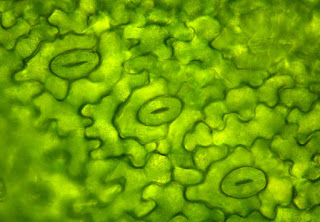As we all know plants are living things. Plants are alive; they grow, eat , reproduce even they show movement but, they can't move like animals in search of food. Because the plants are fixed in the soil at a place, so they cannot move like animals from place to place. the plants can only move parts of their body such as leaves, flowers, shoots and roots. The preparation of carbohydrates(food) by plants by the process of photosynthesis requires two material: Carbon dioxide and water. thus the raw materials for photosynthesis are:
(i) Carbon dioxide, and
(ii) Water.
We will now describe how these two raw material become available to plants for photosynthesis.
1.How the plants obtain carbon dioxide.
There are a large number of tiny pores called stomata on the surface of the leaves of plants.The green plant take carbon dioxide from air for photosynthesis. The carbon dioxide gas enters the leaves of the plant through the stomata present on their surface.
The opening and closing of stomatal pores is controlled by the guard cells. When water floes into the guard cell, they become curved and cause the pore to open, but when the guard cells lose water, they become straight and close the stomatal pore.
Due to which a large amount of water is also lost from the cells of the plant leaves through open stomatal pores. But when the plant does not need carbon dioxide and want to conserve water, the stomatal pores are closed.
Now we can say that stomata allow the movement of gases in and out of plant cells. In other words, gaseous exchange in plants take place through the stomata in leaves.
photosynthesis.
The water required by the plants for photosynthesis is absorbed by the roots of the plants from the soil through the process of osmosis.
The water absorbed by the roots of the plants is transported upward through the xylem vessels to the leaves where it reaches the photosynthetic cells and utilised in photosynthesis.
The water required by the plants for photosynthesis is absorbed by the roots of the plants from the soil through the process of osmosis.
The water absorbed by the roots of the plants is transported upward through the xylem vessels to the leaves where it reaches the photosynthetic cells and utilised in photosynthesis.


Comments
Post a Comment